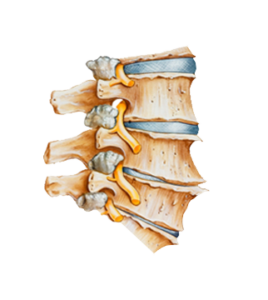
What is Arthritis of the Spine?
Arthritis is defined as painful inflammation and stiffness of the joints. The term is used to describe several conditions. As a matter of fact, over 100 conditions known to date. Arthritis is typically accompanied by joint pain. It is the most common pain-related reason patients visit an orthopedic. Specific joint pain is described as arthralgia.
There are also a couple of known names for joint conditions. When only one joint is involved, this is called monoarthritis. However, when there are more than two, it is known as polyarthritis.
The types of arthritis vary, and there are over one hundred known types today. They vary from wear and tear of cartilage (osteoarthritis) to arthritis associated with inflammation from an overactive immune system (rheumatoid arthritis). All arthritis types, however, collectively account for the most chronic condition in the United States.
Osteoarthritis (OA)
Osteoarthritis occurs when the protective cartilage on the ends of your bones wears down over time. This is sometimes known as degenerative arthritis. Osteoarthritis is a wearing out condition, involving the breakdown of joint cartilage. And once cartilage wears down, the bones will rub against each other, causing stiffness and pain.
Rheumatoid Arthritis (RA)
Rheumatoid arthritis (also known as RA) is a disease that produces chemical changes that cause the synovial membrane (the membrane that surrounds the joint) to become inflamed and thickened. In turn, too much synovial fluid (the fluid that lubricates the joints) is produced. The result of this chronic inflammation is cartilage loss, pain, and stiffness. RA affects women about three times more often than men and may affect other organs of the body, including the skin and heart.
Post-Traumatic Arthritis
Post-traumatic arthritis occurs after any type of injury to the joint. Most commonly resulting in a car accident, fall, military injury, sports, or other physical injury trauma. And due to the cartilage not properly healing. These injuries can damage the joint, making it wear out quicker from continued injury and access body weight.
Paget’s Disease
Paget’s is a degenerative bone disease that interferes with the body’s normal recycling process. Where new bone tissue gradually replaces old bone tissue. This disease can affect this process by causing infected bones to become fragile and misshapen. This disease commonly occurs in the skull, pelvis, spine, and legs.
Avascular Necrosis
Avascular necrosis is developed when a bone is deprived of its blood supply. This typically occurs after longterm cortisone treatments or an organ transplant. And the bone structure weakens and may collapse without proper nutrition from the blood. And then the damage may occur to the cartilage.
Osteoarthritis – Definition
Osteoarthritis is also known as a degenerative joint disease. It is a type of arthritis (joint inflammation) which affects the ligament around joints. Joint cartilage is a gel-like protective tissue. Its found at joint surfaces and provides support and lubrication during movement. During this, the surface layer of this tissue breaks down. And the bones rub together during joint movement and causes:
- pain
- swelling
- restricted movement
It typically can occur in any joint. Osteoarthritis, however, most often involves the hands, knees, hips, and spine.
Osteoarthritis Treatment
When you have been diagnosed with osteoarthritis, the next action is preventative. That includes preventing further joint damage. Typically, lifestyle changes are where treatment begins, such as weight loss, joint-strengthening exercises, and physical therapy.
Your physician might start your treatment with acetaminophen and a non-steroidal anti-inflammatory drug to minimize pain. Later on, surgical options could be discussed. Those surgical options typically include arthroscopy, arthrodesis, or disc replacement to maintain function.
If you suspect you may be living with arthritis of the spine, call us at 888-409-8006. Please seek medical advice from a professional to further evaluate and treatment options.
